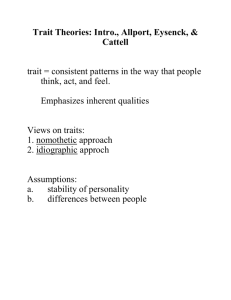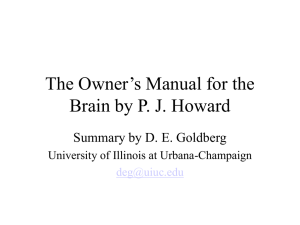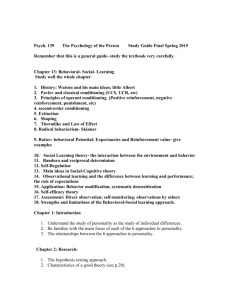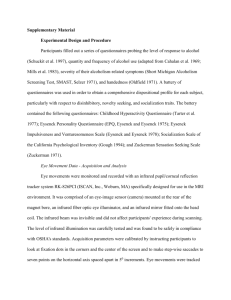Eysenck's theory of the criminal personality
advertisement
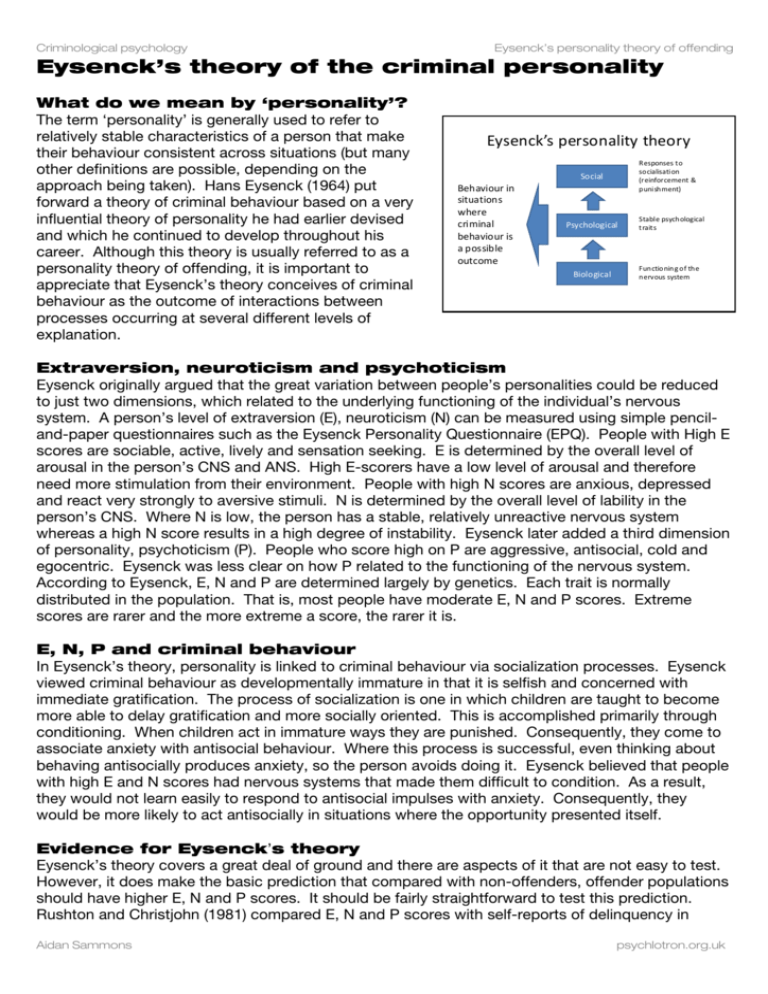
Criminological psychology Eysenck’s personality theory of offending Eysenck’s theory of the criminal personality What do we mean by ‘personality’? The term ‘personality’ is generally used to refer to relatively stable characteristics of a person that make their behaviour consistent across situations (but many other definitions are possible, depending on the approach being taken). Hans Eysenck (1964) put forward a theory of criminal behaviour based on a very influential theory of personality he had earlier devised and which he continued to develop throughout his career. Although this theory is usually referred to as a personality theory of offending, it is important to appreciate that Eysenck’s theory conceives of criminal behaviour as the outcome of interactions between processes occurring at several different levels of explanation. Eysenck’s personality theory Responses to socialisation (reinforcement & punishment) Social Behaviour in situations where criminal behaviour is a possible outcome Psychological Biological Stable psychological traits Functio nin g of the nervous system Extraversion, neuroticism and psychoticism Eysenck originally argued that the great variation between people’s personalities could be reduced to just two dimensions, which related to the underlying functioning of the individual’s nervous system. A person’s level of extraversion (E), neuroticism (N) can be measured using simple penciland-paper questionnaires such as the Eysenck Personality Questionnaire (EPQ). People with High E scores are sociable, active, lively and sensation seeking. E is determined by the overall level of arousal in the person’s CNS and ANS. High E-scorers have a low level of arousal and therefore need more stimulation from their environment. People with high N scores are anxious, depressed and react very strongly to aversive stimuli. N is determined by the overall level of lability in the person’s CNS. Where N is low, the person has a stable, relatively unreactive nervous system whereas a high N score results in a high degree of instability. Eysenck later added a third dimension of personality, psychoticism (P). People who score high on P are aggressive, antisocial, cold and egocentric. Eysenck was less clear on how P related to the functioning of the nervous system. According to Eysenck, E, N and P are determined largely by genetics. Each trait is normally distributed in the population. That is, most people have moderate E, N and P scores. Extreme scores are rarer and the more extreme a score, the rarer it is. E, N, P and criminal behaviour In Eysenck’s theory, personality is linked to criminal behaviour via socialization processes. Eysenck viewed criminal behaviour as developmentally immature in that it is selfish and concerned with immediate gratification. The process of socialization is one in which children are taught to become more able to delay gratification and more socially oriented. This is accomplished primarily through conditioning. When children act in immature ways they are punished. Consequently, they come to associate anxiety with antisocial behaviour. Where this process is successful, even thinking about behaving antisocially produces anxiety, so the person avoids doing it. Eysenck believed that people with high E and N scores had nervous systems that made them difficult to condition. As a result, they would not learn easily to respond to antisocial impulses with anxiety. Consequently, they would be more likely to act antisocially in situations where the opportunity presented itself. Evidence for Eysenck’s theory Eysenck’s theory covers a great deal of ground and there are aspects of it that are not easy to test. However, it does make the basic prediction that compared with non-offenders, offender populations should have higher E, N and P scores. It should be fairly straightforward to test this prediction. Rushton and Christjohn (1981) compared E, N and P scores with self-reports of delinquency in Aidan Sammons psychlotron.org.uk Criminological psychology Eysenck’s personality theory of offending schoolchildren and students. They found that those who reported higher levels of delinquency also scored higher on E, P and N. These correlations are consistent with Eysenck’s prediction. However, studies of ‘official’ delinquency (e.g. comparing convicted offenders with non-offenders) do not produce such clear cut results. Farrington et al (1982) reviewed 16 studies of the relationship between E, N and P measures with criminal convictions. They found that in the majority of cases offenders scored higher on P and N but not on E. Hollin (1989) notes a similar pattern of findings: offenders generally show higher P and N scores but not necessarily higher E scores. It is not clear why the relationship between E and offending is so inconsistent. One possibility is that E scales actually measure two things, sociability and impulsiveness and that criminality is associated with the latter but not the former (Putwain & Sammons, 2002). Evaluation of Eysenck’s theory There is some empirical support for Eysenck’s theory, but a number of critics have argued that the data are flawed. Research in this area relies heavily on the self-report measures of personality devised by Eysenck and colleagues. Some (including Farrington et al) have suggested that these scales are subject to response bias. There is also the issue that research has made heavy use of comparisons between convicted offenders and the general population. Such research inevitably excludes those who commit crimes and are not caught and convicted. Consequently, many of these studies may only be telling us about the personality characteristics of ‘unsuccessful’ offenders. Leaving aside the issues of sampling and response bias there is an argument that the theory itself is somewhat circular. Take the example of the psychoticism scale. To measure P, respondents answer ‘yes’ or ‘no’ to a series of statements about whether they act aggressively and selfishly. Their scores on such scales are then used to ‘explain’ why high P-scorers act aggressively and antisocially. This is rather unsatisfactory and P remains a significant weakness of Eysenck’s theory since it is far from clear what (if anything) it measures. A further issue arises from the way Eysenck conceived of personality as a set of stable traits which cause people to behave consistently across situations. As noted above, this is just one of a range of possible approaches to personality. Situationalist theories of personality suggest that no such consistency really exists. Mischel (1968), for example, argues that the apparent consistency in people’s behaviour is an illusion that arises from the fact that we typically observe people in similar situations. If we accept this line of argument then we must question the existence of the stable personality traits on which Eysenck’s theory rests. Howitt (2009) explores a number of problems with Eysenck’s theory. Whilst applauding its attempt to integrate different levels of theorising (genetic, biological, psychological and social) Howitt notes that the broad sweep of Eysenck’s theory actually addresses few of the real concerns of forensic psychologists, who are more interested in questions about specific types of crime. Eysenck’s theory tells us that rapists and child abusers are extravert, neurotic and psychotic, but it does not tell us why they rape or abuse children. This criticism could equally be levelled at any of the theories of general criminality that have been put forward since Lombroso. On the other hand, Eysenck’s theory may point in some useful directions where it comes to preventing crime. His theory suggests that the underlying tendencies that eventually manifest themselves as criminal behaviour are detectable in childhood and that it may be possible to modify the socialization experiences of high-risk individuals so that they do not develop into offenders. This could lead to interventions based on parenting or early treatment for delinquency and hence may be of great practical benefit in reducing criminal behaviour. Aidan Sammons psychlotron.org.uk

